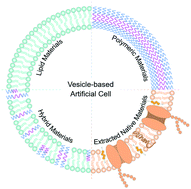Vesicle-based artificial cells: materials, construction methods and applications
Abstract
The construction of artificial cells with specific cell-mimicking functions helps to explore complex biological processes and cell functions in natural cell systems and provides an insight into the origins of life. Bottom-up methods are widely used for engineering artificial cells based on vesicles by the in vitro assembly of biomimetic materials. In this review, the design of artificial cells with a specific function is discussed, by considering the selection of synthetic materials and construction technologies. First, a range of biomimetic materials for artificial cells is reviewed, including lipid, polymeric and hybrid lipid/copolymer materials. Biomaterials extracted from natural cells are also covered in this part. Then, the formation of microscale, giant unilamellar vesicles (GUVs) is reviewed based on different technologies, including gentle hydration, electro-formation, phase transfer and microfluidic methods. Subsequently, applications of artificial cells based on single vesicles or vesicle networks are addressed for mimicking cell behaviors and signaling processes. Microreactors for synthetic biology and cell–cell communication are highlighted here as well. Finally, current challenges and future trends for the development and applications of artificial cells are described.

- This article is part of the themed collection: Recent Review Articles


 Please wait while we load your content...
Please wait while we load your content...